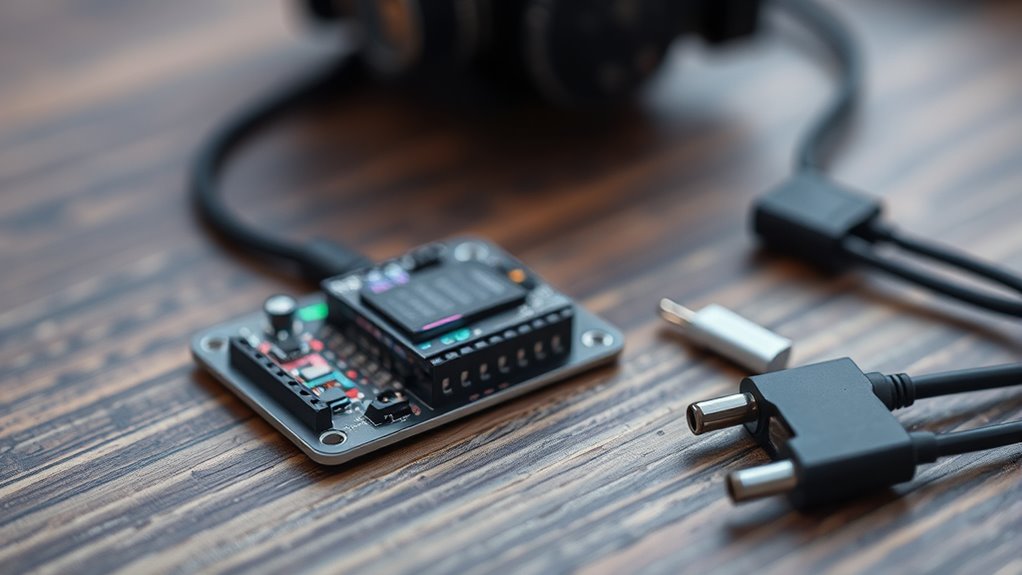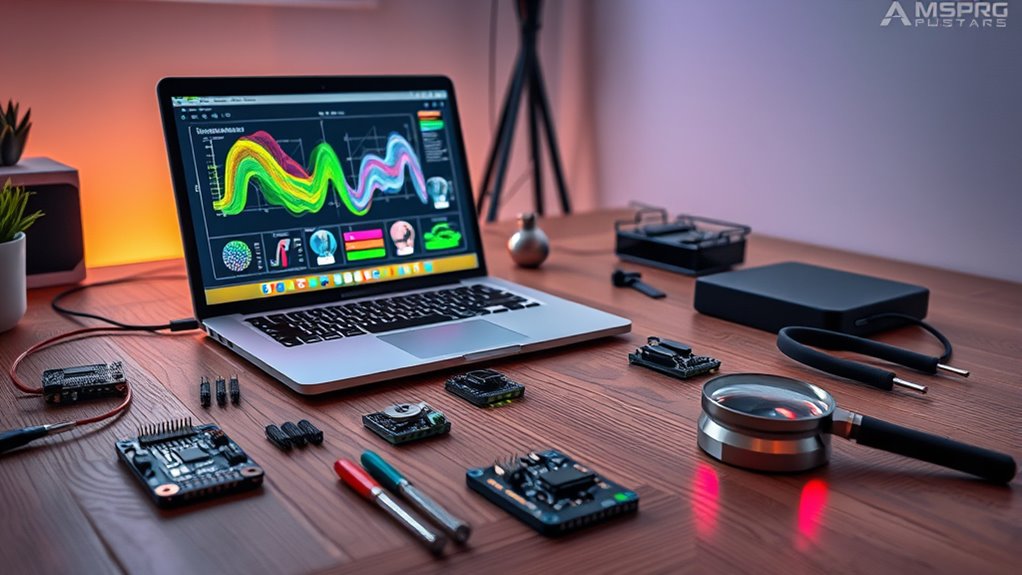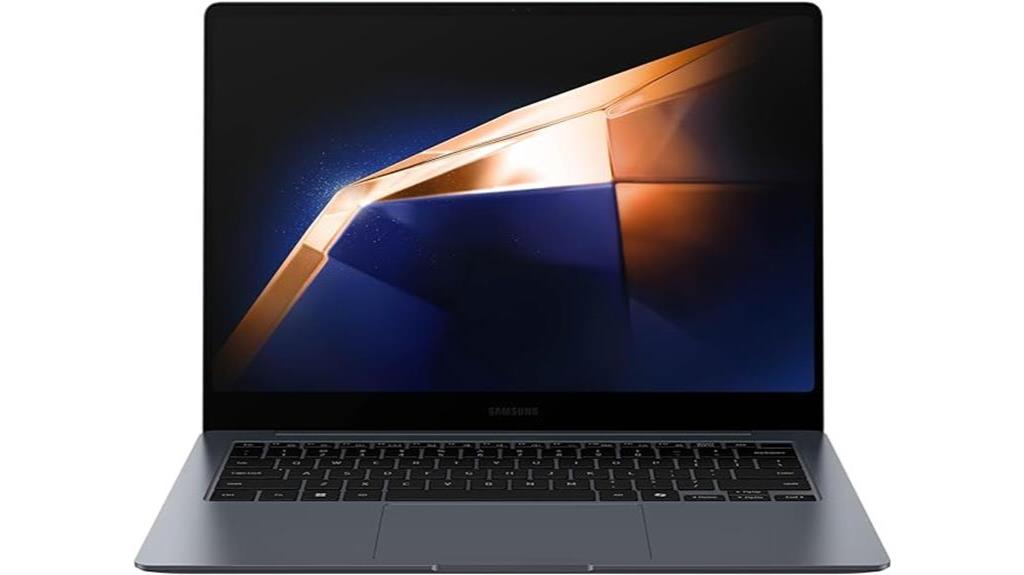If you’re looking to elevate your AI vision projects in 2025, I recommend exploring top kits like the ELECFREAKS Smart AI Lens Kit, Sipeed MaixCAM Pro, and NVIDIA Jetson Nano modules. These combine affordability, powerful performance, and versatility for beginners and experts alike. From stereo cameras to deep learning boards, there’s something for every level. Keep going; you’ll discover more about each option and how they can transform your projects.
Key Takeaways
- Beginner-friendly kits like ELECFREAKS and Yahboom offer accessible AI vision features for educational and entry-level robotics projects.
- Advanced modules such as Sipeed MaixCAM Pro and NVIDIA Jetson Nano enable real-time AI inference and complex vision tasks.
- Diverse sensor integration kits support robotics development, obstacle avoidance, face recognition, and multi-sensor experimentation.
- High-performance cameras and stereo modules facilitate depth sensing, high-res imaging, and autonomous navigation capabilities.
- Kits with user-friendly interfaces, expansion options, and multimedia features enhance project interactivity and customization.
ELECFREAKS Smart AI Lens Kit with Recognition Function and Mini Screen
If you’re looking for an AI vision sensor kit that’s perfect for students and educators, the ELECFREAKS Smart AI Lens Kit with Recognition Function and Mini Screen is a top choice. It features recognition capabilities for faces, cards, colors, and balls, making it versatile for many AI projects. The kit includes a compact 1.3-inch mini screen and connects easily with micro:bit expansion boards, requiring no extra power source. Designed for users over 10, it’s great for educational use, with simple graphical programming and compatibility with Lego blocks and robot cars. I find it straightforward to integrate and perfect for hands-on learning.
Best For: educators, students, and hobbyists seeking an easy-to-use AI vision sensor kit for interactive projects and learning activities.
Pros:
- Recognizes faces, cards, colors, and balls, enabling diverse AI applications.
- Compatible with micro:bit expansion boards and Lego blocks, supporting various DIY projects.
- Simple graphical programming and no extra power source required make it user-friendly for beginners.
Cons:
- Limited to 3.3V~5V micro:bit compatibility, may require additional adapters for other platforms.
- The small 1.3-inch mini screen might limit detailed display options.
- Customer ratings are moderate (4.1/5), indicating some users may experience integration or performance issues.
Sipeed MaixCAM Pro AI RISC-V Development Board Kit
The Sipeed MaixCAM Pro AI RISC-V Development Board Kit stands out as an ideal choice for developers and hobbyists seeking a powerful, versatile platform for AI vision projects. It features a 1GHz RISC-V processor, 256MB RAM, and 32GB onboard storage, supporting advanced AI models like YOLOv8. The kit includes a 5MP camera, a 2.3-inch touch screen, and connectivity options like WiFi6 and Bluetooth 5.4. It’s compatible with multiple operating systems and development environments, making model deployment straightforward. With hardware decoding for video and support for various peripherals, it’s perfect for object detection, surveillance, and robotics projects.
Best For: hobbyists, developers, and researchers seeking a compact, high-performance AI vision platform for prototyping, robotics, and surveillance projects.
Pros:
- Powerful 1GHz RISC-V processor with support for advanced AI models like YOLOv8
- Versatile connectivity options including WiFi6 and Bluetooth 5.4, plus multiple peripheral interfaces
- Supports hardware-accelerated video decoding and AI inference, suitable for real-time applications
Cons:
- Short cables and internal SD card access may require careful handling and assembly
- Limited onboard RAM (256MB) could constrain large-scale or complex AI models
- Dependence on external accessories (e.g., thermal camera) for specialized features like thermal imaging
IMX219-83 Stereo Binocular Camera Sensor Module
The IMX219-83 Stereo Binocular Camera Sensor Module stands out for its dual 8-megapixel IMX219 cameras, making it ideal for developers working on depth sensing and 3D perception projects. It supports popular platforms like NVIDIA Jetson Nano, Xavier NX, and Raspberry Pi CM3/CM3+ boards, including Compute Module IO and POE variants. Each camera offers an 83-degree diagonal field of view, enabling high-resolution stereo imaging. Although some users report minor alignment issues, the module’s compatibility with C++ code and all-encompassing documentation make it accessible. It’s a versatile choice for robotics, machine vision, and 3D mapping, enhancing AI vision applications with reliable stereo depth data.
Best For: AI developers and robotics enthusiasts seeking a high-resolution stereo camera module compatible with popular single-board computers for depth sensing and 3D perception projects.
Pros:
- High-resolution dual 8MP IMX219 cameras suitable for detailed stereo imaging
- Compatible with NVIDIA Jetson Nano, Xavier NX, and Raspberry Pi CM3/CM3+ boards, including Compute Module IO and POE variants
- Comprehensive documentation and C++ code support facilitate easier integration
Cons:
- Some users report minor misalignment between the two cameras affecting stereo accuracy
- Missing connection cables for Raspberry Pi 5, requiring additional purchases
- Noisy gyro sensors and calibration challenges noted by a few users
Compatible with NVIDIA Jetson Nano Camera IMX219-160 8MP Camera Module
Designed for developers and hobbyists working with NVIDIA Jetson Nano, the IMX219-160 8MP Camera Module offers high-resolution imaging with a wide 160° angle. It features an IMX219 sensor, supporting 3280×2464 pixels, ideal for AI applications like face recognition or license plate detection. The module connects via CSI interface, with included cables, and fits compactly at 25mm×24mm. Compatibility extends to Jetson Nano, Jetson Orin Nano, Raspberry Pi models, and Compute Modules. Its lightweight design and easy Linux setup make it perfect for rapid prototyping. Just guarantee proper cable orientation and power supply, and you’re ready to capture stunning images for your project.
Nexbit Smart Robot Kit for Microbit V2 with AI Vision Camera
If you’re looking to introduce beginners to robotics and AI vision applications, the Nexbit Smart Robot Kit for Microbit V2 is an excellent choice. This compact kit features an HD WonderCam AI vision module that handles tasks like color recognition, line following, and target tracking. It includes a high-precision line follower, ultrasonic sensor, infrared receiver, and RGB lights, making it versatile for STEM projects. With easy Makecode programming and control options via app or remote, it’s perfect for learning and experimentation. Although Microbit V2 isn’t included, this educational starter kit simplifies complex AI concepts for learners aged 16 and up.
Best For: beginners and students aged 16 and up interested in learning robotics, AI vision applications, and STEM education through an easy-to-use, educational starter kit.
Pros:
- Includes an HD WonderCam AI vision module for versatile AI applications like color recognition and target tracking
- Supports multiple control options, including Makecode programming, mobile app control, and remote control for flexible learning
- Compact and lightweight design makes it portable and easy to handle for beginners
Cons:
- Microbit V2 is not included, requiring an additional purchase to complete the kit
- Might be limited for advanced robotics projects due to its beginner-focused features
- Some users could find the graphical programming interface less suitable for more complex programming tasks
Yahboom Toy Robotic Kit for Microbit STEM Projects
For kids and beginners interested in exploring AI vision, the Yahboom Toy Robotic Kit for Microbit STEM Projects offers an engaging way to learn coding through hands-on robot building. The kit emphasizes visual autonomous driving, face recognition, barcode detection, and feature analysis, helping children grasp AI concepts creatively. The Tinybit Pro upgrade adds advanced features like a K210 vision module and support for image programming languages, enabling real AI vision experiments. It includes remote control options and expandability with traffic sign recognition and obstacle avoidance. Yahboom also provides tutorials and technical support, making this kit ideal for young learners enthusiastic to explore autonomous robotics and AI in their projects.
Best For: young beginners and kids interested in exploring AI, robotics, and coding through hands-on STEM projects with easy-to-use visual programming and expandability options.
Pros:
- Offers a comprehensive STEM learning experience with AI vision capabilities like face and barcode recognition.
- Includes remote control and expandability features such as traffic sign recognition and obstacle avoidance.
- Comes with tutorials and professional support, making it accessible for beginners and educational use.
Cons:
- Requires a Microbit development board, which may be an additional initial investment.
- Autonomous driving relies on infrared sensors rather than visual line tracking, limiting some automation features.
- Advanced features like AI vision and map expansion may be complex for very young or inexperienced users.
HiLetgo 37 Sensor Assortment Kit for Arduino & Raspberry Pi
The HiLetgo 37 Sensor Assortment Kit for Arduino & Raspberry Pi stands out as an excellent choice for beginners and hobbyists who want a wide variety of sensors and modules in one package. It includes touch sensors, infrared, temperature, magnetic sensors, LEDs, buzzers, relays, joysticks, and more, making it versatile for many projects. The components are compatible with 5V systems and are mostly plug-and-play, ideal for those just starting out. Packaged in a sturdy plastic case with a helpful photo guide, it offers great value and easy organization. While some parts may have quality issues, it’s perfect for exploration, learning, and testing ideas.
Best For: beginners, hobbyists, and educators seeking an affordable, comprehensive sensor kit for Arduino and Raspberry Pi projects.
Pros:
- Wide variety of sensors and modules in one affordable package
- Compatible with 5V systems and mostly plug-and-play, suitable for beginners
- Organized in a sturdy plastic case with a helpful photo guide for easy identification
Cons:
- Some components may have quality issues or arrive DOA
- Limited documentation and unclear part identification for advanced users
- Basic components more suitable for exploration rather than complex or professional projects
Yahboom K230 AI Development Board with 1.6GHz Chip and 2.4-inch Display
The Yahboom K230 AI Development Board stands out for those seeking high-performance processing in a compact, user-friendly package. Equipped with a 1.6GHz chip, it delivers 13.7 times the KPU power and 8.5 times the CPU power of the K210, enabling real-time handling of complex AI models. The 2.4-inch touch LCD and 2MP camera facilitate easy debugging and control. Its flexible 12-pin GPIO interface supports various sensors and modules, and compatibility with multiple controllers simplifies integration. With a pre-installed GUI and tutorials, it’s ideal for education, maker projects, and industrial applications, offering a seamless experience for both beginners and seasoned developers.
Best For: hobbyists, educators, and developers seeking a high-performance, easy-to-use AI development platform for complex image and voice processing projects.
Pros:
- Exceptional processing power with a 1.6GHz chip and significantly enhanced KPU and CPU capabilities.
- User-friendly pre-installed GUI and comprehensive tutorials suitable for beginners and educational purposes.
- Flexible expansion options with multiple compatible controllers and sensors, facilitating diverse project integrations.
Cons:
- May be overpowered for simple or basic AI applications, potentially increasing cost and complexity.
- The detailed feature set and compatibility options could be overwhelming for complete novices.
- Limited display size at 2.4 inches, which might restrict certain visual interface applications.
38-in-1 Sensor Modules Kit with OLED for Arduino and Raspberry Pi
If you’re just starting out with Arduino or Raspberry Pi projects, the in-1 Sensor Modules Kit with OLED stands out as an accessible way to explore a variety of sensors in a single package. It includes 38 modules, such as temperature, humidity, obstacle avoidance, heartbeat, and infrared sensors, plus a compact OLED display. Designed for beginners and hobbyists, it supports IoT applications, allowing remote control and monitoring. Despite some mixed reviews on build quality, the kit offers a wide range of components to experiment with, making it ideal for learning, prototyping, and developing smart home solutions. It’s a versatile starting point for expanding your sensor-based projects.
Best For: beginners and hobbyists looking to explore a wide variety of sensors for Arduino, Raspberry Pi, and IoT projects, especially in educational, prototyping, and smart home applications.
Pros:
- Offers a comprehensive set of 38 sensor modules and an OLED display, suitable for diverse experiments and learning.
- Affordable and versatile, making it accessible for beginners to start exploring sensor-based projects.
- Compatible with popular microcontrollers like Arduino, Raspberry Pi, and STM32, facilitating easy integration.
Cons:
- Mixed reviews regarding build quality, with reports of damaged or defective components.
- Lack of detailed documentation and instructions, which may pose challenges for beginners.
- Some sensors may not function properly or at all, potentially requiring replacements or upgrades for reliable use.
Sipeed LicheeRV Nano RISC-V Development Board
For developers seeking a compact, versatile AI vision sensor platform, the Sipeed LicheeRV Nano RISC-V Development Board stands out with its powerful onboard NPU capable of delivering 1 TOPS INT8 performance. It features a 1GHz SG2002 processor (with RISC-V/ARM options), 256MB DDR3 RAM, and dual-boot support via TF card or SD NAND. The board offers excellent multimedia capabilities, including 2-lane MIPI DSI display support, 4-lane MIPI CSI input, and onboard audio features like a PA amplifier and microphone. Connectivity options include WiFi 6, Bluetooth 5.2, Ethernet, and USB, making it ideal for embedded AI and vision projects.
Best For: embedded AI developers and vision system engineers seeking a compact, high-performance platform with versatile multimedia and connectivity features.
Pros:
- Robust onboard NPU delivering 1 TOPS INT8 performance ideal for AI inference tasks
- Rich multimedia interfaces including dual-lane MIPI DSI display and 4-lane MIPI CSI input for advanced video applications
- Multiple connectivity options such as WiFi 6, Bluetooth 5.2, Ethernet, and USB support for versatile networking
Cons:
- Limited 256MB RAM may constrain large-scale or memory-intensive applications
- Compact size (22.86 x 35.56mm) could limit expansion or add-on options
- Requires some technical expertise for configuring optional features like Bluetooth activation or network setup
Yahboom AI Robot Kit Tank Chassis for Raspberry Pi 4B
Designed specifically for Raspberry Pi 4B, the Yahboom AI Robot Kit Tank Chassis stands out as an excellent choice for hobbyists and educators seeking a versatile, expandable platform. Its solid aluminum alloy chassis, powerful 370 motors, and durable tracks ensure reliable performance and off-road ability. The kit supports multiple expansion boards, including UNO R3 and STM32, allowing for DIY customization. Equipped with sensors like ultrasonic modules, line inspection, and advanced AI features such as face detection and object recognition, it enables complex projects. The included 2DOF camera gimbal supports real-time HD video transmission via 5G Wi-Fi, making it perfect for interactive robotics and AI experiments.
Best For: hobbyists, educators, and students interested in DIY robotics, AI projects, and STEM education using a versatile, expandable platform.
Pros:
- Durable aluminum alloy chassis and high-quality components for reliable off-road performance
- Supports multiple expansion boards and advanced AI features like face detection and object recognition
- Includes real-time HD video transmission with a 2DOF camera gimbal via 5G Wi-Fi hotspot
Cons:
- Requires a Raspberry Pi 4B (not included) to operate, adding to overall cost
- Setup and programming may require some technical knowledge, especially for beginners
- Limited to 480P resolution for video transmission, which might not suffice for high-definition needs
Robotic Arm with Arduino UNO (5DOF/Axis) STEM Robotics Kit
The Robotic Arm with Arduino UNO (5DOF/Axis) STEM Robotics Kit stands out as an excellent choice for beginners and hobbyists enthusiastic to explore robotics. Built on the Atmega328 platform, it’s compatible with Arduino programming and offers open-source software and tutorials. The hardware features high-precision digital servos, Bluetooth control, and expansion ports for sensors like ultrasonic or cameras. It’s easy to assemble, affordable, and versatile, making it perfect for educational demos and personal projects. While the software can be tricky for beginners, the kit’s robust design and expandability foster creativity and hands-on learning, inspiring future engineers and makers.
Best For: beginners, hobbyists, and educators interested in exploring robotics, programming, and STEM projects with an easy-to-assemble, versatile robotic arm.
Pros:
- High-quality hardware with precise digital servos and expandable ports for sensors and modules
- User-friendly assembly process and affordable pricing make it accessible for educational and personal use
- Supports multiple control options including Bluetooth, manual knobs, and offline programming, fostering creativity
Cons:
- Software and tutorials may be superficial and challenging for beginners without advanced Arduino experience
- Limited detailed guidance can hinder understanding of code functions and autonomous capabilities
- Some users find integrating cameras or complex sensors requires additional effort and troubleshooting
Sipeed Maix-II Dock Deep Learning AI+IOT Linux 1080P Vision Development Kit
The Sipeed Maix-II Dock stands out as an ideal choice for developers seeking an accessible yet powerful AI vision sensor kit. It features the Maix-II core module with a built-in NPU and Allwinner V831 SoC, supporting 1080p vision processing. The kit includes a baseboard for quick testing and runs Linux-based Sipeed MAIX-LINUX firmware with Python and Jupyter Notebook integration. Its compact design, lightweight at 2.39 ounces, makes it perfect for embedded projects. With fast connectivity options like Bluetooth and flexible software support, this development kit simplifies AI inference and edge computing, making it a versatile tool for vision-based applications.
Best For: developers and hobbyists seeking an affordable, compact AI vision development kit with powerful edge computing and easy software integration.
Pros:
- Equipped with a built-in NPU for accelerated AI inference and 1080p vision processing capabilities.
- Supports Linux-based firmware with Python and Jupyter Notebook, facilitating straightforward AI development.
- Compact, lightweight design with versatile connectivity options like Bluetooth, ideal for embedded projects.
Cons:
- Limited to entry-level edge computing performance, which may not suffice for high-end AI applications.
- Small form factor might require additional peripherals for expanded functionality.
- Only four user reviews on Amazon, which may limit early feedback and community support.
Yahboom K210 and K230 Vision Sensor Modules
If you’re looking for versatile AI vision sensor modules suitable for edge applications, Yahboom’s K210 and K230 modules stand out with their high-performance chips and all-encompassing features. The K210 offers a dual-core 64-bit processor, a 2MP camera, a touchscreen, and supports face recognition, QR code scanning, and more. The K230 boosts processing power with a 6TOPS chip, a 2MP camera, a larger touchscreen, microphone, and WiFi, enabling human pose detection, object recognition, and behavior analysis. Both modules come with open-source code, detailed tutorials, and 32GB TF card support, making them ideal for real-time AI vision projects.
Best For: enthusiasts and developers seeking versatile edge AI vision modules for real-time projects such as face recognition, object detection, and behavior analysis.
Pros:
- High-performance chips with 1TOPS (K210) and 6TOPS (K230) processing power for complex AI tasks.
- Open-source code and comprehensive tutorials facilitate easy development and customization.
- Supports 32GB TF cards, touchscreen interfaces, and multiple recognition functions for versatile applications.
Cons:
- Larger modules may require more space and power management considerations.
- The K230’s higher processing power may lead to increased cost and complexity for beginners.
- Limited connectivity options beyond WiFi and serial ports may restrict integration with some systems.
SunFounder PiCrawler AI Robot Kit for Raspberry Pi (RPi not included)
Designed for hobbyists and educators enthusiastic to explore AI robotics, the SunFounder PiCrawler AI Robot Kit offers impressive features like 12 servos and advanced sensors, making it ideal for creating dynamic, interactive projects. It’s compatible with Raspberry Pi 5/4/3B+/3B/Zero 2W (RPi not included) and includes a rechargeable battery. The robot mimics realistic spider movements with four legs and smooth, precise actions such as walking, turning, and tricks. Equipped with a camera for face detection and color recognition, plus ultrasonic sensors for obstacle avoidance, it also integrates ChatGPT-4o for natural language interaction, making learning engaging and versatile.
Best For: hobbyists and educators eager to explore AI robotics with a versatile, interactive robot kit compatible with multiple Raspberry Pi models.
Pros:
- Features 12 servos and advanced sensors for realistic spider-like movements and interactions.
- Integrates ChatGPT-4o for natural language communication and programming guidance.
- Includes comprehensive online resources, technical support, and an active community for easy learning.
Cons:
- RPi is not included, requiring an additional purchase.
- May be complex for complete beginners without prior experience in robotics or programming.
- Heavily reliant on Raspberry Pi compatibility, limiting use with other hardware platforms.
Factors to Consider When Choosing AI Vision Sensor Kits

When choosing an AI vision sensor kit, I consider how well it works with my existing devices and the specific recognition features I need. Ease of programming, power options, and connectivity are also key factors that impact my experience. Finally, I look at the price and support options to guarantee I get the best value and assistance.
Compatibility With Devices
Choosing an AI vision sensor kit requires careful attention to device compatibility to guarantee smooth integration. I always check if the kit supports my microcontroller, single-board computer, or development platform, like Raspberry Pi, NVIDIA Jetson, or Arduino. Interface compatibility is equally important; I verify if the sensor’s connectors—CSI, MIPI, GPIO pins, or FPC—match my device’s input options. It’s also essential to confirm I have the right cables or adapters, especially for specialized ports like FFC or custom connectors. Power requirements matter too; I verify the sensor’s voltage and power needs align with my device’s output to avoid damage. Finally, I look for software support and SDK compatibility with my operating system to enable seamless integration and peak performance.
Recognition Capabilities Offered
The recognition capabilities of AI vision sensor kits vary widely, impacting their suitability for different applications. Some kits excel at basic detection like faces, objects, colors, QR codes, barcodes, and road signs, making them versatile for many projects. Advanced kits may include facial landmark detection, mask recognition, and behavioral analysis, enabling more detailed insights. The accuracy of these functions depends on sensor quality, neural network models, and calibration. High-performing kits often support real-time recognition with fast processing speeds, ideal for dynamic tasks like autonomous vehicles or interactive robots. Compatibility with AI models such as MobileNetV2, YOLO, or custom-trained networks also plays a vital role in recognition performance. Choosing the right kit depends on matching these capabilities to your project’s specific needs.
Ease of Programming
Selecting an AI vision sensor kit becomes much easier when you prioritize ease of programming, as it directly affects how quickly you can get started and troubleshoot. I recommend choosing kits that support visual programming environments like Makecode or Scratch, which require no extensive coding knowledge. Look for modules with pre-installed graphical interfaces or simplified SDKs to reduce setup complexity. Kits with extensive tutorials, sample codes, and user-friendly documentation make learning and troubleshooting much smoother. Opt for sensors offering drag-and-drop or block-based programming options, making AI vision tasks accessible for beginners. Additionally, ensure the kit supports common programming languages like Python or C++, so you have flexibility to develop your skills further. These features greatly streamline the programming process, helping you focus on your project’s innovation.
Power and Connectivity Options
Power and connectivity options are crucial factors that can make or break your experience with an AI vision sensor kit. I look for kits offering compatible power ranges, like 3.3V to 5V, and reliable sources to prevent malfunctions. Multiple interfaces such as USB, CSI, MIPI, UART, or WiFi/Bluetooth are essential for seamless integration with various systems. I also consider whether the kit supports wireless communication, like WiFi 6, BLE, or Ethernet, for flexible deployment and remote control. Ensuring the presence of compatible cables, adapters, or expansion ports saves time and effort connecting to existing hardware. Ultimately, I prioritize kits with stable, secure connection protocols to maintain reliable data transmission during intensive AI vision processing. These features collectively ensure smooth operation and versatile connectivity for my projects.
Price and Support Availability
Price and support availability are critical factors that can considerably influence your overall satisfaction with an AI vision sensor kit. I recommend comparing prices across online and offline stores to guarantee you get the best value within your budget. It’s also essential to check if the manufacturer offers a warranty or guarantee period, which can save you money and headaches if defects occur. Verify whether technical support, tutorials, and customer service are accessible, as these resources are invaluable during setup and troubleshooting. Additionally, see if the product provides firmware updates, software improvements, or online resources to enhance your experience over time. Ultimately, review the seller’s policies on returns, refunds, and price matching so you’re protected if issues arise. These factors ensure you get both a reliable product and ongoing support.
Frequently Asked Questions
Which AI Vision Sensor Kit Offers the Easiest Integration With Existing Projects?
You’re wondering which AI vision sensor kit is easiest to integrate with your existing projects. I’ve found that kits with thorough documentation, plug-and-play modules, and strong community support make the process smoother. For me, those with simple APIs and compatible interfaces stand out. I recommend checking out kits like the Intel RealSense or the Raspberry Pi Camera Module, as they’re user-friendly and widely supported, making integration straightforward and hassle-free.
What Is the Typical Power Consumption of These AI Vision Sensors?
Imagine you’re building a security drone; power consumption matters. Typically, AI vision sensors like the Intel RealSense consume around 2 to 5 watts during active processing. In a real-world case, this allows for extended flight times without sacrificing performance. I find that understanding these specs helps me plan battery needs better, ensuring my projects run smoothly. Most sensors are designed to balance performance with power efficiency for practical use.
How Do These Kits Perform in Low-Light or Challenging Environmental Conditions?
When it comes to low-light or challenging environments, I find that these AI vision sensor kits perform quite well thanks to integrated features like infrared illumination and advanced image processing. They can adapt to poor lighting conditions and still deliver clear, accurate results. I recommend checking each kit’s specifications, but overall, these sensors are designed to handle tough environments, making them reliable for various projects.
Are There Open-Source Software Options Compatible With These AI Vision Sensors?
You’re probably wondering if open-source software works well with these AI vision sensors. I’ve found that many popular options like OpenCV and TensorFlow are highly compatible and flexible, making integration straightforward. They offer extensive libraries and community support, so you can customize your projects easily. Plus, open-source tools are continually improving, giving you the freedom to experiment and optimize your sensor setups without extra costs.
What Is the Average Development Time to Implement a Functional AI Vision Project?
When I consider how long it takes to develop a functional AI vision project, I find it varies based on complexity. Usually, I spend a few weeks to several months, depending on factors like data quality, hardware setup, and algorithm tuning. I always recommend starting with clear goals and modular steps to stay on track. Patience and iterative testing help me make sure the system works reliably before deployment.
Conclusion
Choosing the right AI vision sensor kit can truly transform your projects. Imagine creating a home security system that detects intruders in real-time—this kit could make it happen. Whether you’re a hobbyist or a professional, understanding your needs helps you pick the perfect match. So, get inspired, experiment boldly, and watch your ideas come to life. The right kit is the first step toward innovation and success in 2025!

























